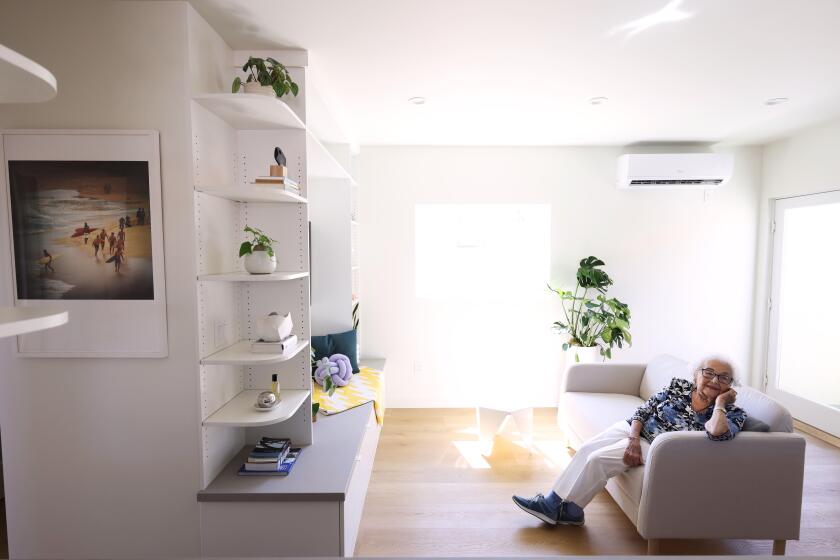Plan Unveiled for $10-Million Renovation of 3rd Street Mall
More than 18 months of study, debate, proposals and counterproposals have yielded a $10-million renovation plan for Santa Monica’s Third Street Mall, an outdoor shopping area that has been widely described as an urban eyesore.
The plan, which was unveiled last week, is one of the biggest redevelopment proposals in recent Santa Monica history and may not be completed until the year 2000. It contains a comprehensive plan for transforming the downtrodden three-block mall into a low-rise, European-style shopping plaza with cafes, theaters, shops, department stores, nightclubs and a luxury hotel.
Thomas H. Carroll, executive director of the nonprofit Third Street Development Corp., said the plan for the mall, which is bounded by Wilshire Boulevard on the north and Broadway on the south, was developed and supported by a broad coalition of community leaders and residents. The City Council will act on the 118-page plan sometime during the summer, Carroll added.
City Would Pay One-Third
About one-third of the $10-million renovation cost would be borne by the city. The remainder would come from a special assessment district that would issue bonds. Mayor Christine E. Reed, who appeared with Carroll at a crowded press conference, predicted swift council approval of the ambitious plan.
“It has been seen by the council in other stages before,” Reed said. “I don’t think the city will go over this with a fine-toothed comb. You will find that there’s broad-based support for what (the planners) are trying to do.”
Councilman Herb Katz, who helped develop the plan, called it “one of the most exciting things I’ve seen happen in Santa Monica.”
Councilman Dennis Zane, who also worked on the plan, called the mall the “heart of Santa Monica.” He said the corporation’s plans, which include adding 900 parking spaces, redesigning the mall’s public space and upgrading alleys running throughout the complex, are sure to spark revitalization.
“We expect the livability of the mall to be significantly enhanced,” Zane said this week. “It will be more of a gardenlike environment.”
Built in the Mid-1960s
The Third Street Mall, which was built in the mid-1960s, is currently dominated by dime stores, thrift shops, jewelry stores and fast-food restaurants. Officials said the complex has suffered from a pattern of “decline, deterioration and disinvestment” for several years.
A major blow came in 1980, when the Santa Monica Place shopping area opened next door. Other cities have bulldozed outdoor shopping malls, but Santa Monica officials said the Third Street Mall has the potential to succeed.
The mall’s biggest asset is its location, according to Carroll. The ocean, which attracts thousands of visitors, is just three blocks away. The mall is also near several office buildings and the famed Santa Monica Pier.
The lion’s share of the restoration is expected to be done during the next five years. But Carroll said he expects the mall to attract more than $100 million in private business investment over a 15-year period. He said he also expects 1 million square feet of renovation and new construction at the mall. The historic Keller Block building, at Broadway and 3rd Street, is already undergoing a $2-million restoration. The mall has also attracted a few new offices, restaurants and retailers, Carroll added.
“The mall is beginning to show some very encouraging signs,” Carroll said. “The 18-month planning process has already generated changes.”
Carroll’s group was also encouraged by a professional market analysis of the mall, which found that the area can support the changes being proposed.
Report Says Need Exists
“The market area of the Third Street Mall exhibits a demand for retail, offices, hotel and residential uses,” the report concluded. “There is a significant gap between what currently exists on the mall and what could be reasonably captured. The absence of a major new development given these demands can be attributed largely to the mall’s poor image.”
Edward Wenner, the president of a mall property owners association, said his organization supports the plan. Wenner said he and his partners have already committed more than $5 million to private mall restoration efforts.
“It is very difficult to find a place like this,” Wenner said. “I’ve read the whole plan and I think it’s great. . . . This place has been stagnant. But now something is going to happen.”
A handful of business people who attended the press conference said they support the plan as a way to improve lagging sales. Those merchants and others who remain will face higher rents and assessment district taxes once the improvements are made. But Carroll said very few have objected to the plans.
Walking through the mall after the press conference, Carroll was confronted by one merchant who asked whether construction would block the entrance to his business and prevent people from coming in. Carroll said he didn’t think so.
“I guess it doesn’t really matter,” the merchant said upon reflection. “I don’t have any business anyway.”
More to Read
Sign up for Essential California
The most important California stories and recommendations in your inbox every morning.
You may occasionally receive promotional content from the Los Angeles Times.










